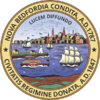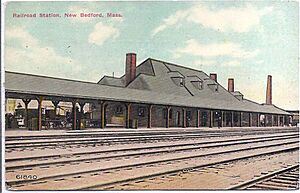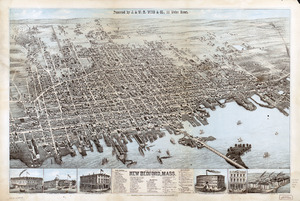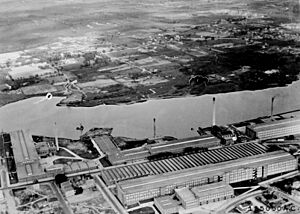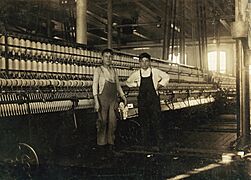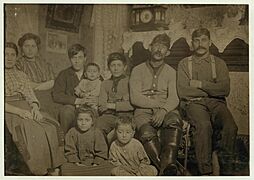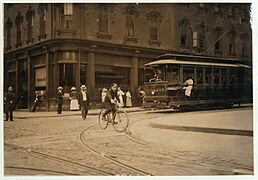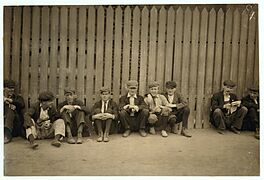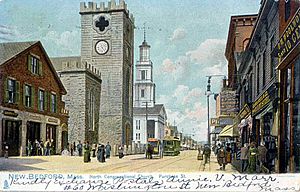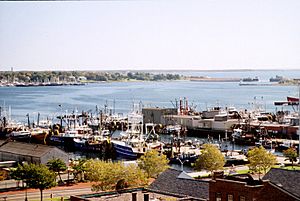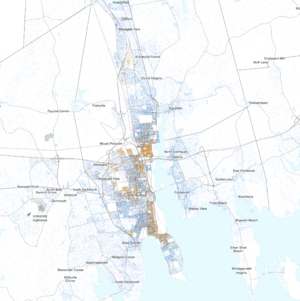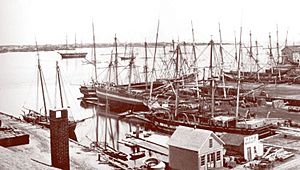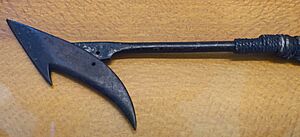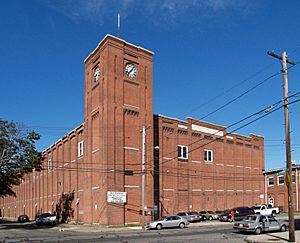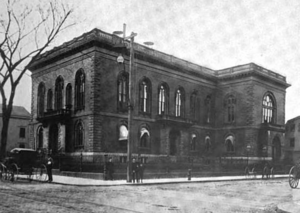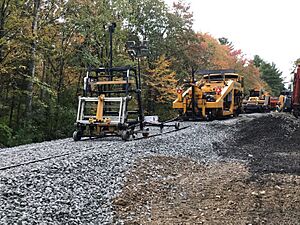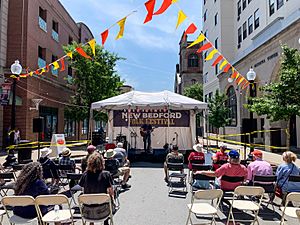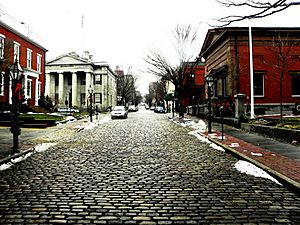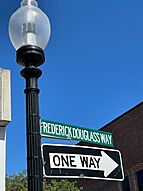New Bedford, Massachusetts facts for kids
Quick facts for kids
New Bedford, Massachusetts
|
|||
|---|---|---|---|
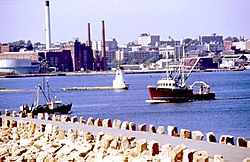
Skyline of Center City from New Bedford Harbor
|
|||
|
|||
| Nickname(s):
"The Whaling City"
|
|||
| Motto(s):
Lucem Diffundo (Latin)
"I Diffuse Light" |
|||
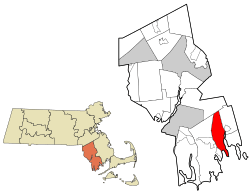
Location in Bristol County, Massachusetts
|
|||
| Country | |||
| State | |||
| County | Bristol | ||
| Settled | 1652 | ||
| Incorporated (town) | 1787 | ||
| Incorporated (city) | 1847 | ||
| Government | |||
| • Type | Mayor–council | ||
| Area | |||
| • Total | 24.13 sq mi (62.50 km2) | ||
| • Land | 20.00 sq mi (51.80 km2) | ||
| • Water | 4.13 sq mi (10.70 km2) | ||
| Elevation | 50 ft (15 m) | ||
| Population
(2020)
|
|||
| • Total | 102,882 | ||
| • Density | 5,053.70/sq mi (1,951.25/km2) | ||
| Time zone | UTC−5 (Eastern) | ||
| • Summer (DST) | UTC−4 (Eastern) | ||
| ZIP Code |
02740, 02744–02746
|
||
| Area code(s) | 508/774 | ||
| FIPS code | 25-45000 | ||
| GNIS feature ID | 0613714 | ||
New Bedford is a city in Bristol County, Massachusetts, United States. It sits on the Acushnet River in the South Coast area. It is the biggest city in this region.
Before the 17th century, the Wampanoag Native Americans lived here. English settlers bought the land in 1652. English Quakers founded the first settlement in the late 1600s. New Bedford officially became a town in 1787.
In the early 1800s, New Bedford was a very important whaling port. It was known as "The Whaling City." During this time, it was one of the richest cities in North America. New Bedford was also a key place for the movement to end slavery. Many freed or escaped African-American slaves came here, including Frederick Douglass. He lived in New Bedford from 1838 to 1841. The city is also featured in Herman Melville's famous 1851 novel, Moby-Dick.
In 2020, New Bedford had about 101,079 people. This makes it the ninth-largest city in Massachusetts. The city is also known for having many Portuguese Americans. Today, New Bedford is famous for its fishing fleet and seafood industry. In 2019, it was the top fishing port in the U.S. by value. You can also visit the New Bedford Whaling Museum and New Bedford Whaling National Historical Park here.
Contents
A Look at New Bedford's Past
Before the 1600s, the Wampanoag Native Americans lived along the Acushnet River. They had villages across southeastern Massachusetts and Rhode Island. This included places like Martha's Vineyard and Nantucket. About 12,000 Wampanoag people lived there.
On May 15, 1602, an English explorer named Bartholomew Gosnold landed on Cuttyhunk Island. He was exploring New England. He explored the area where New Bedford is now. Gosnold later moved to the Jamestown Colony in Virginia.
Old Dartmouth's Beginnings
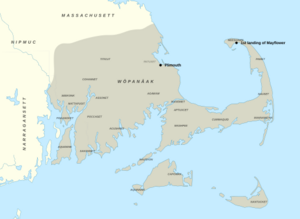
In 1652, English colonists bought a large area called Old Dartmouth. This area is now Dartmouth, Acushnet, New Bedford, Fairhaven, and Westport. The Wampanoag leaders, Chief Ousamequin (Massasoit) and his son Wamsutta, agreed to the sale.
The English thought they fully owned the land. But the Wampanoag saw things differently. They did not have the same idea of land ownership. They thought they were only selling hunting, fishing, and farming rights.
Quakers Settle In
Members of the Religious Society of Friends, also called Quakers, were early European settlers. They faced harsh treatment in the Puritan areas of Plymouth Colony and Massachusetts Bay Colony. The Massachusetts Bay Colony even banned Quakers in 1656–1657.
By 1691, when Massachusetts Bay Colony took over Plymouth Colony, Quakers were the majority in Old Dartmouth. In 1699, Quakers built their first meeting house there. It is where the Apponegansett Meeting House stands today.
At first, Old Dartmouth had no big town centers. It had separate farms and small villages. People liked their freedom from Plymouth Colony. They did not want the court to assign them a minister.
The economy mainly relied on farming and fishing. Many Quakers and Baptists moved here. They came from Newport and Portsmouth in Rhode Island. More Puritans also moved to the area.
King Philip's War
More Europeans meant more demand for land. This made relations with Native Americans worse. European settlers often ignored the Old Dartmouth Purchase terms. This led to King Philip's War in 1675.
During this war, Wampanoag fighters, along with the Narragansett and Nipmuc, attacked European settlements. In Old Dartmouth, Europeans found safety in strong homes. These included John Russell's home at Russells Mills. Also, John Cooke's home in Fairhaven, and a third fort on Palmer Island.
New Bedford's Founding
A part of Old Dartmouth, called Bedford Village, became the town of New Bedford. This happened on February 23, 1787, after the American Revolutionary War. The Russell family, important people in the area, suggested the name. The Dukes of Bedford in England also had the last name Russell. (Bedford, Massachusetts, was named earlier in 1729, so this one became "New" Bedford.)
The late 1700s were a time of growth. A small whale fishery started. There was also some international trade. From 1760 to 1770, skilled workers like shipbuilders and blacksmiths moved to New Bedford harbor. They created a strong maritime community.
New Bedford's first newspaper, The Medley, started in 1792. The town opened its first post office on June 12, 1792. A bridge between New Bedford and Fairhaven was built in 1796. This also helped the town grow. Fairhaven became a separate town in 1812.
The Whaling City Era
Nantucket used to be the main whaling port. But a group of merchants in Boston, Newport, and Providence controlled the industry. In the 1760s, Nantucket's top whaling families moved to New Bedford. They began making their own oil and candles.
The American Revolutionary War stopped the whaling business. British forces blocked American ports and attacked ships. They even marched into New Bedford and burned businesses. Nantucket was even more exposed. The war destroyed its wealth.
New Bedford had a deeper harbor and was on the mainland. So, it took over from Nantucket as the top whaling port. This began the Golden Age of Whaling. Important Quaker businessmen like William Rotch and Samuel Rodman were key to this industry.
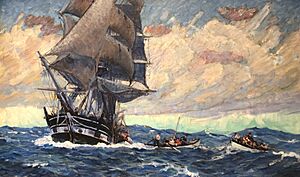
After the War of 1812, New Bedford began building many large whaling ships. Many were built in Mattapoisett. Whalers invented "tryworks" on board. These were big iron pots over a furnace. They allowed whalers to process blubber into oil at sea. This meant ships could stay at sea for up to four years. They returned with barrels of oil, spermaceti, and sometimes ambergris.
Whaling was New Bedford's main business for much of the 1800s. Many families worked in it. Quakers remained important and powerful. They used their religious values in business. They promoted stability and growth. They invested in things like railroads. They hired people fairly, without discrimination. They built strong ties with Boston, New York, and Philadelphia. This connected New Bedford to the big cities of the Northeast.
Ten thousand men worked in whaling. New Bedford's population grew from 4,000 in 1820 to 24,000 in 1860. In 1857, at the peak of whaling, the harbor had 329 ships. They were worth over $12 million. New Bedford became the richest city per person in North America.
On March 18, 1847, New Bedford officially became a city. Abraham Hathaway Howland was elected its first mayor.
A Place of Opportunity
The Quakers in New Bedford believed in egalitarianism (equal rights for all) and community. They used these ideas in their businesses. People from many backgrounds found work in New Bedford. This included British, Wampanoag, Cape Verdean, Azorean, Irish, and West African people.
New Bedford also became an early center for ending slavery. It was an important stop on the Underground Railroad. Many people were drawn to New Bedford's open-minded spirit. For example, Paul Cuffe, a Black and Wampanoag Quaker, was a very successful businessman. He helped Black property owners in New Bedford get the right to vote. This was decades before Abraham Lincoln signed the Emancipation Proclamation.
Lewis Temple, an African-American blacksmith, invented the Temple toggle iron. This was a very successful harpoon design. Frederick Douglass, a famous social reformer, found safety in New Bedford. He worked at the wharf for three years.
Whaling Industry Declines
The whaling industry started to decline after 1859. That year, petroleum was discovered in Pennsylvania. Petroleum began to replace whale oil. Each decade, whaling work and income slowly decreased.
During the Civil War, the Confederacy attacked Union whaling ships. They wanted to hurt the U.S. economy. The U.S. government also bought many inactive whaling ships. They filled them with stones and sank them in Charleston, South Carolina. This was an attempt to block the Confederate bay. This event, called the Stone Fleet, further hurt the struggling whaling industry.
Textile Industry Rises
As whaling declined, New Bedford's economy turned to the textile industry. This industry grew very quickly in the late 1800s. Mills were built along the Acushnet River. In 1875, the Wamsutta Mills alone processed 19,000 bales of cotton. This made 20 million yards of cloth. This cloth was worth as much as the entire whaling catch. The Wamsutta Mills was the world's largest weaving plant until 1892.
The textile mills brought new wealth to New Bedford. This wealth was even greater than from whaling. With this money, New Bedford developed a lively art scene. The Mount Washington Glass Company made beautiful glass and silver items. You can see examples of these at the New Bedford Whaling Museum.
In the 1920s, textile factories in the South offered lower wages. This put pressure on New Bedford mills. In 1928, mill owners wanted to cut wages by 10 percent. This led to a strike. The strike ended in October, with a 5 percent wage cut. But wage cuts were not enough to stop the long-term decline of the local textile industry.
- Photographs taken by Lewis Hine for the NCLC.
Waves of Immigration
Before 1800, New Bedford was mostly settled by Protestants from England, Scotland, Wales, and the Netherlands. In the early 1800s, many Irish immigrants came to Massachusetts. In 1818, Irish immigrants started a Catholic church, St. Mary's.
Later in the 1800s, immigrants from Portugal and its islands arrived. These included people from Cape Verde, the Azores, and Madeira. They came for jobs in the whaling industry. Many had family who worked on whaling ships. As the Portuguese community grew, they built the first Portuguese church, St. John the Baptist (1871). French Canadians also settled here and built the Church of the Sacred Heart in 1877.
Polish immigrants arrived in the late 1800s. They built the church of Our Lady of Perpetual Help in 1903. Many Jewish families also came in the late 1800s. They were active in the whaling business. Before World War I, a large Jewish community from Eastern Europe joined them. Some became important merchants, especially in textiles.
New Bedford Today

Fishing and manufacturing are still big businesses here. Healthcare has also become a major employer. The biggest employers in New Bedford are Southcoast Hospitals Group (healthcare), Titleist (golf products), and Riverside Manufacturing (clothing).
In 2001, a study showed the top jobs in the New Bedford area were services (26%), wholesale trade (22%), and manufacturing (19%). The biggest industries were health services, restaurants, wholesale trade, food stores, and social services.
The city hopes to become a center for wind energy. In 2016, companies started leasing parts of New Bedford's Marine Commerce Terminal. They plan to use it to build wind turbines.
Important Buildings and Sites
The Ash Street Jail is in New Bedford. It opened in 1829 and is the oldest jail in the U.S. that is still in use.
Fort Taber and Fort Rodman were built during the American Civil War. They are now part of Fort Taber Park.
New Bedford's Location and Features
New Bedford is a coastal city and a seaport. It is bordered by Dartmouth to the west, Freetown to the north, Acushnet and Fairhaven to the east, and Buzzards Bay to the south. The city covers about 62.5 square kilometers (24.13 square miles). About 51.8 square kilometers (20 square miles) is land, and 10.7 square kilometers (4.13 square miles) is water.
The Port of New Bedford, also called New Bedford Harbor, is where the Acushnet River meets Buzzards Bay. A two-mile-long hurricane barrier protects the inner harbor. This barrier was built in the 1960s. The city also includes Fish Island and Pope's Island. The Roland J. Herbert Bridge connects these islands and the mainland. It has a swing bridge section that lets boats pass.
City Parks and Green Spaces
There are many parks and playgrounds in New Bedford. Some even have splash pads! Here are some of the main parks:
- Abolition Row Park
- Acushnet Cedar Swamp State Reservation
- Allen C. Haskell Public Gardens
- Ashley Park
- Baby Kenney Tot Lot
- Brooklawn Park
- Buttonwood Park
- Captain Jack Peterson Dog Park
- Clasky Common Park
- Custom House Square
- Flora B. Pierce Nature Trail
- Fort Rodman/Taber Park
- Hazelwood Park
- Marine Park at Pope's Island
- New Bedford Covewalk
- New Bedford Whaling National Historical Park
- Ricketson's Nature Trail
- River's End Park
- Riverside Park
- Roberto Clemente Park
- Ross C. Mathieu Nature Trail
- Victory Park Community Gardens
New Bedford's Climate
New Bedford has a climate that is a mix of humid subtropical and humid continental. This means it has clear seasons. Winters are a bit milder than places further inland. It rains or snows a lot throughout the year.
| Climate data for New Bedford, Massachusetts (1991–2020 normals, extremes 1893–2002) | |||||||||||||
|---|---|---|---|---|---|---|---|---|---|---|---|---|---|
| Month | Jan | Feb | Mar | Apr | May | Jun | Jul | Aug | Sep | Oct | Nov | Dec | Year |
| Record high °F (°C) | 67 (19) |
69 (21) |
80 (27) |
96 (36) |
98 (37) |
102 (39) |
103 (39) |
107 (42) |
94 (34) |
90 (32) |
79 (26) |
74 (23) |
107 (42) |
| Mean daily maximum °F (°C) | 38.1 (3.4) |
39.6 (4.2) |
46.8 (8.2) |
56.1 (13.4) |
67.5 (19.7) |
78.1 (25.6) |
84.0 (28.9) |
82.2 (27.9) |
75.3 (24.1) |
64.2 (17.9) |
52.7 (11.5) |
43.2 (6.2) |
60.7 (15.9) |
| Daily mean °F (°C) | 30.1 (−1.1) |
31.2 (−0.4) |
38.0 (3.3) |
47.9 (8.8) |
58.6 (14.8) |
68.9 (20.5) |
75.6 (24.2) |
74.0 (23.3) |
67.1 (19.5) |
56.4 (13.6) |
45.1 (7.3) |
35.7 (2.1) |
52.4 (11.3) |
| Mean daily minimum °F (°C) | 22.1 (−5.5) |
22.8 (−5.1) |
29.1 (−1.6) |
39.6 (4.2) |
49.6 (9.8) |
59.8 (15.4) |
67.2 (19.6) |
65.8 (18.8) |
59.0 (15.0) |
48.5 (9.2) |
37.4 (3.0) |
28.3 (−2.1) |
44.1 (6.7) |
| Record low °F (°C) | −10 (−23) |
−12 (−24) |
4 (−16) |
16 (−9) |
31 (−1) |
39 (4) |
47 (8) |
44 (7) |
30 (−1) |
20 (−7) |
8 (−13) |
−11 (−24) |
−12 (−24) |
| Average precipitation inches (mm) | 3.82 (97) |
4.07 (103) |
5.34 (136) |
4.57 (116) |
3.73 (95) |
4.15 (105) |
3.58 (91) |
4.07 (103) |
4.22 (107) |
4.88 (124) |
4.59 (117) |
5.19 (132) |
52.21 (1,326) |
| Average snowfall inches (cm) | 10.9 (28) |
8.5 (22) |
6.6 (17) |
1.7 (4.3) |
0.0 (0.0) |
0.0 (0.0) |
0.0 (0.0) |
0.0 (0.0) |
0.0 (0.0) |
0.0 (0.0) |
0.4 (1.0) |
4.4 (11) |
32.5 (83) |
| Average precipitation days (≥ 0.01 in) | 11.3 | 10.6 | 11.8 | 12.2 | 11.3 | 9.6 | 7.9 | 9.0 | 9.7 | 8.3 | 10.3 | 11.6 | 123.6 |
| Average snowy days (≥ 0.1 in) | 4.3 | 3.7 | 2.7 | 0.6 | 0.0 | 0.0 | 0.0 | 0.0 | 0.0 | 0.0 | 0.3 | 2.2 | 13.8 |
| Source: NOAA | |||||||||||||
People of New Bedford
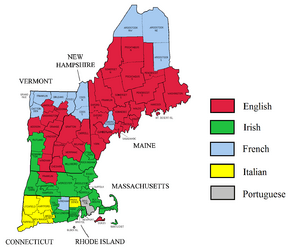
| Historical population | |||
|---|---|---|---|
| Census | Pop. | %± | |
| 1790 | 3,313 | — | |
| 1800 | 4,361 | 31.6% | |
| 1810 | 5,651 | 29.6% | |
| 1820 | 3,947 | −30.2% | |
| 1830 | 7,592 | 92.3% | |
| 1840 | 12,087 | 59.2% | |
| 1850 | 16,443 | 36.0% | |
| 1860 | 22,300 | 35.6% | |
| 1870 | 21,320 | −4.4% | |
| 1880 | 26,845 | 25.9% | |
| 1890 | 40,783 | 51.9% | |
| 1900 | 62,442 | 53.1% | |
| 1910 | 96,652 | 54.8% | |
| 1920 | 121,217 | 25.4% | |
| 1930 | 112,597 | −7.1% | |
| 1940 | 110,341 | −2.0% | |
| 1950 | 109,189 | −1.0% | |
| 1960 | 102,477 | −6.1% | |
| 1970 | 101,777 | −0.7% | |
| 1980 | 98,478 | −3.2% | |
| 1990 | 99,922 | 1.5% | |
| 2000 | 93,768 | −6.2% | |
| 2010 | 95,072 | 1.4% | |
| 2020 | 101,079 | 6.3% | |
| 2023 (est.) | 100,695 | 5.9% | |
| U.S. Decennial Census | |||
New Bedford and nearby towns are part of the Providence metropolitan area. This larger area has the biggest Portuguese-American community in the United States.
In 2020, New Bedford had 101,079 people. The city is very diverse. About 33.8% of people are of Portuguese background. Other groups include Puerto Rican (10.1%), French (9.1%), Cape Verdean (8.8%), Irish (6.9%), and English (5.3%).
The average household had 2.40 people. The average family had 3.01 people. About 24.9% of the population was under 18 years old. The median age was 36 years.
Kʼicheʼ Community
New Bedford has a community of Kʼicheʼ people from Guatemala. They came to the U.S. to escape the Guatemalan Civil War. Many Kʼicheʼ men moved to New Bedford from Providence, Rhode Island, starting in the late 1980s.
In 2019, a group that helps the Maya people said that the New Bedford School District was not providing enough Kʼicheʼ language services. The U.S. Department of Justice and the school district worked together. They found a way for the school district to provide better Kʼicheʼ language services.
New Bedford's Economy
From Whaling to Textiles
The first settlers in the New Bedford area mostly farmed and fished. But Bedford Village quickly became a trading center. It grew into a major whaling and foreign trade port. In the early 1700s, the Russell family helped develop it.
By the 1700s, whaling merchants from Nantucket were drawn to the village. They helped make it one of the top whaling cities. Joseph Rotch, a key merchant, moved his business here in 1765. He thought New Bedford was better for refining whale oil and making candles.
New Bedford and Nantucket worked together to lead the whaling industry. In 1848, New Bedford resident Lewis Temple invented the toggling harpoon. This invention changed whaling and helped New Bedford become the top American city for it. Also, whaling ships became larger and needed deeper harbors, which Nantucket lacked.
The clipper ship Syren carried whale oil to New Bedford for over ten years. Because it controlled whaling products like whale oil, New Bedford became one of the richest cities in the world per person.
Many whalers left their jobs in 1849. The Gold Rush attracted them to California. During this time, Herman Melville, who worked as a whaler in New Bedford, wrote Moby-Dick. The city is where the book begins.
The whaling industry started to decline in 1859. This was when petroleum was discovered. It began to replace whale oil. The whaling disaster of 1871 also hurt the industry. In this event, 22 New Bedford whalers were lost in the ice off Alaska. The last whaling expedition from New Bedford was in 1925.
New Bedford stayed wealthy because of its textile industry. Starting in 1881, the textile industry grew very large. At its peak, over 30,000 people worked for 32 cotton-making companies. These factories were worth $100 million. The New Bedford Textile School opened in 1895–1899. This started a time of textile success. But it began to decline in the Great Depression and ended in the 1940s.
Tourism and Fishing Today
tourism is growing in New Bedford. The city hosts many fairs and festivals. These include the Whaling City Festival, Jazzfest, and the Portuguese Feast of the Blessed Sacrament. This feast is the biggest Portuguese cultural event in the U.S.
Tourism also focuses on the historic whaling industry. The New Bedford Whaling National Historical Park teaches about whaling's impact on U.S. history. The Buttonwood Park Zoo has many animals, including two Asian Elephants.
In 2010, a new hotel opened in New Bedford. It was the first hotel to open in the city in over 40 years.
Despite the decline of whaling, the Port of New Bedford is still a top fishing port. From 1999 to 2019, New Bedford was the most valuable commercial fishing port in the U.S. In 2019, the fish caught here were worth $451 million. New Bedford's catch is valuable because scallops make up 84% of its fishing income.
Getting Around New Bedford
By Water
The Port of New Bedford is a big harbor for cargo and passenger boats. It creates over $9.8 billion in economic value each year. The port handles fresh goods like fruit and fish. It is also a stop for cruise ships.
Several private ferry services leave from New Bedford. SeaStreak offers fast ferry service to Martha's Vineyard and Nantucket. The Cuttyhunk Ferry Company runs ferries to Cuttyhunk Island. Ferry service from New Bedford started on May 15, 1818.
New Bedford has always been important for whaling and fishing. Today, it is still a key fishing site. In 2020, the Port of New Bedford was the number one fishing port in the U.S. by the value of its catch. In 2015, New Bedford fishermen caught 124 million pounds of fish, worth $322 million.
By Air
New Bedford Regional Airport (EWB) is in the middle of the city. It has two long runways. Cape Air and Southern Airways Express offer regular flights to Nantucket and Martha's Vineyard. Since 2020, New Bedford Regional Airport has been the main base for Southern Airways Express in New England.
The airport also offers services for private planes and corporate jets. This includes maintenance and flight lessons.
By Road
Interstate 195 is the main highway through New Bedford. It goes from Providence, Rhode Island, to Wareham. U.S. Route 6 also runs through the city. It crosses the New Bedford-Fairhaven Bridge to Cape Cod.
New Bedford is the southern end of MA Route 140. This highway connects to MA Route 24 in Taunton, on the way to Boston. MA Route 18 is a short highway that connects I-195 to US 6 and the port area.
By Bus
The city bus terminal offers local and long-distance bus connections. A free shuttle bus connects the terminal to the ferries. The Southeastern Regional Transit Authority (SRTA) provides bus service within the city and to nearby areas like Fall River.
Peter Pan Bus Lines stops in New Bedford on its route from New York City to Hyannis (Cape Cod). DATTCO also provides daily bus service to Boston.
By Rail
The South Coast Rail project is building a new train line. It will bring passenger train service back to New Bedford and Fall River. Passenger service stopped in 1958. Efforts to bring it back started in the 1980s. Construction began on July 2, 2019. The project is expected to be finished by the end of 2023.
The Massachusetts Coastal Railroad provides freight train service to New Bedford. Several old rail yards are being fixed up for future freight services.
Learning in New Bedford
Public Schools
New Bedford Public Schools is the local school district. New Bedford High School is the only public high school in the city.
New Bedford is also home to Greater New Bedford Regional Vocational-Technical High School. This big school teaches trades and skills. It serves New Bedford, Dartmouth, and Fairhaven.
The city has two alternative high schools: Whaling City Alternative School and Trinity Day Academy. There are also two charter schools: Global Learning Charter Public School (GLCPS) and Alma del Mar Charter School.
Other Schools
There are three Catholic schools in the city. They are run by the Roman Catholic Diocese of Fall River.
- All Saints Catholic School – Formed in 2010 by merging St. Mary and St. Joseph-Therese schools.
- St. Teresa of Calcutta School – Formed in 2022 by merging St. James St. John School and Holy Family-Holy Name School.
Some students from these schools go on to Bishop Stang High School in nearby Dartmouth. There are also two Catholic preschools.
Other independent schools include Nazarene Christian Academy, Nativity Prep (for boys), and Our Sisters' School (for girls).
Higher Education
New Bedford has a campus of Fisher College. It helps adults learn from the New Bedford area. Bristol Community College also has a campus downtown.
Nearby Dartmouth is home to the University of Massachusetts Dartmouth campus. It also has the University of Massachusetts School of Law - Dartmouth. The University of Massachusetts Dartmouth has a marine campus at Fort Rodman.
Bridgewater State University Aviation is based at the New Bedford Regional Airport. It offers degrees in Flight Training and Aviation Management.
The Greater New Bedford Regional Vocational-Technical High School also offers adult education classes.
City Library
The New Bedford public library started in 1852. It has a main library and several branches.
- Main Library
- Casa da Saudade (Portuguese branch)
- Howland-Green Library
- Lawler Library
- Wilks Library
- Bookmobile
Law Enforcement
The New Bedford Police Department provides law enforcement in New Bedford.
Media and News
New Bedford is part of the Providence TV market. WLNE-TV (Channel 6) is the ABC station. WLWC (Channel 28) is a Court TV station. The Portuguese Channel has its offices and studios in the city.
The city has three radio stations: WJFD-FM/97.3 (Portuguese-language), WNBH-FM/101.3, and WNBH-AM/1340.
In 2021, "New Bedford Light" (https://newbedfordlight.org) started. It is a free online news site that provides in-depth reporting.
The city also has two newspapers: the New Bedford Standard-Times and The Portuguese Times.
New Bedford's Culture
Literature Connections
Herman Melville is linked to New Bedford. His 1851 novel Moby-Dick is set in the city. The New Bedford Whaling Museum holds an annual event where people read the entire novel aloud.
Artistic Heritage
Many famous artists are from New Bedford or have ties to it. These include Benjamin Russell, Clement Nye Swift, Clifford Warren Ashley, and Albert Pinkham Ryder. William Bradford is another notable artist.
In 2018, a very long painting called Grand Panorama of a Whaling Voyage Round the World was shown. It was painted by Caleb Purrington and Benjamin Russell in 1848. It shows a whaling trip starting from New Bedford.
Music Scene
New Bedford has had successful musicians. In the 1970s, Tavares, an Rhythm and blues group of five brothers from New Bedford, had hit songs like "Heaven Must Be Missing an Angel." In 1999, the pop group LFO, with member Harold "Devin" Lima from New Bedford, had a hit with "Summer Girls."
Have Heart, a Straight-edge hardcore band, formed in New Bedford in 2002. The hardcore punk band A Wilhelm Scream also gained success. New Bedford natives Hector Barros and Scott Ross were in the hip-hop group Marky Mark and the Funky Bunch. They had a number one hit with "Good Vibrations" in 1991.
Quinn Sullivan (born 1999) is a blues guitarist from New Bedford. He has played with famous musicians like Buddy Guy and B.B. King.
The accordion player Aldo DeRossi (1917–2010) wrote the Whaling City Concerto in 1992, honoring New Bedford.
The city is home to the Zeiterion Performing Arts Center. This is where the New Bedford Symphony Orchestra performs.
Summerfest, a folk music festival, started in 1996. By 2012, it was attracting many people and was renamed the New Bedford Folk Festival. The festival held its 25th and final event in 2022.
Sports Teams
New Bedford had a professional baseball team called The New Bedford Whalers from 1895 to 1915. Another team, the New Bedford Millmen, played for one season in 1929. A second Whalers team played in 1933–1934.
A team from New Bedford won the 1977 Pony League World Series.
Since 2009, the city has been home to the New Bedford Bay Sox baseball team. They are part of a college summer baseball league. They play home games at Paul Walsh Field.
Fun Events
New Bedford hosts many events. These include the Feast of the Blessed Sacrament, the New Bedford Folk Festival, the Whaling City Festival, and Jazzfest. AHA! (Art, History, and Architecture) Nights are free cultural events held every month downtown.
Places to Visit
Museums to Explore
New Bedford is home to the New Bedford Whaling Museum. It is the main part of the New Bedford Whaling National Historical Park. This is the largest museum in the country about whaling. It shows how humans and whales have interacted throughout history. The museum has skeletons of a 66-foot-long baby blue whale, a 35-foot-long humpback whale, and a 45-foot-long sperm whale.
The Rotch-Jones-Duff House and Garden Museum is a large Greek Revival mansion. It was built in 1834 for a whaling merchant. Three important families owned the house between 1834 and 1981. It was restored in the 1980s and became a museum. It shows 150 years of life in New Bedford.
The New Bedford Fire Museum is in an old fire station that opened in 1867. It has a collection of old firefighting equipment and fire engines. You can also look at old city fire records from 1890. Retired and active firefighters work as guides.
The New Bedford Museum of Glass shows the city's history with glass companies. The museum has glass from ancient times to today. It focuses on glass from New England. It also has a library with many books about glass. The museum is in one of the historic Wamsutta Mills textile factory buildings.
Historic Areas
New Bedford has nine historic districts listed on the National Register of Historic Places. These areas are protected for their historical importance. They include:
- Acushnet Heights Historic District
- Buttonwood Park Historic District
- Central New Bedford Historic District
- County Street Historic District
- Howland Mill Village Historic District
- Merrill's Wharf Historic District
- Moreland Terrace Historic District
- New Bedford Historic District
- North New Bedford Historic District
Famous People from New Bedford
Paul Cuffee, a merchant and ship captain, was born nearby. Many of his ships sailed from New Bedford.
Lewis Temple was an African-American blacksmith. He invented the toggle iron, a type of toggling harpoon. This invention made whaling much more successful. There is a monument to Temple in downtown New Bedford.
In 1838, Frederick Douglass, an escaped slave who became a famous abolitionist, settled in New Bedford. He wrote about life in New Bedford in his autobiography. A historic building and monument for Douglass can be found at the Nathan and Polly Johnson properties.
New Bedford was a welcoming place for many escaped slaves and freedmen. It had a strong African-American community before the Civil War. Many members of the 54th Massachusetts Regiment were from New Bedford. This was the first U.S. regiment made entirely of African-American soldiers. One famous soldier was William Harvey Carney. He made sure the American flag never touched the ground during a battle. An elementary school in New Bedford is named after him.
Patrick Cunningham was an Irish immigrant and inventor. He was known for building a torpedo.
Bishop "Sweet Daddy" Grace, from Brava, Cape Verde, lived in New Bedford. He founded a large African-American church group. He is buried in New Bedford.
- Clifford Warren Ashley, author and artist, famous for The Ashley Book of Knots.
- Joseph "The Animal" Barboza, mob hitman.
- Merton J. Batchelder, Marine Corps general in World War II.
- André Bernier, first meteorologist on The Weather Channel.
- Albert Bierstadt, 19th-century artist known for American West paintings.
- Ezell A. Blair Jr. (Jibreel Khazan), civil rights activist.
- Millicent Borges Accardi, poet with family roots in New Bedford's Portuguese community.
- Franklin Brownell (1857–1946), painter and teacher.
- William Harvey Carney, American soldier and Medal of Honor recipient.
- Paul Clayton, folksinger.
- Lewis Henry Douglass, Union Army sergeant major in the American Civil War.
- William Edgar Easton, playwright and journalist.
- Nelson Eddy, singer and movie star.
- William Greenleaf Eliot, co-founder of Washington University in St. Louis.
- Elizabeth Piper Ensley, educator and activist.
- Marie Equi, 19th-century doctor and labor activist.
- Keith Francis, middle-distance runner.
- Hetty Green, wealthy businesswoman.
- Henry Grinnell, businessman who funded Arctic expeditions.
- Carol Haney, choreographer for films like Singin' in the Rain.
- Brian Helgeland, screenwriter and director.
- Irwin M. Jacobs, co-founder of Qualcomm.
- Samantha Johnson, singer.
- Tynisha Keli (born 1985), singer.
- Joe Lacob, owner of the Golden State Warriors.
- Rebecca Hammond Lard, first poet of Indiana.
- George N. Leighton, United States District Court judge.
- Dave Leitao, basketball head coach.
- Léo Major, Canadian Soldier.
- William Foster Nye (1824–1910), businessman.
- William and Amelia Piper, abolitionists and conductors on the Underground Railroad.
- Paul Poirier, former boxing champion.
- Brian Pothier, professional ice hockey player.
- Ben Powers (1950–2015), actor.
- Albert Pinkham Ryder, 19th-century painter.
- Laurie Santos (born 1975), Yale University professor.
- Jared Shuster (born 1998), MLB pitcher.
- Lois Tripp Slocum (1899–1951), astronomer.
- Pete Souza, Chief Official White House Photographer.
- Harry Stovey, 19th-century professional baseball player.
- Jordan Todman (born 1990), NFL player.
- Benjamin Tucker, author.
- John Tukey, statistician.
- Bobby Watkins, professional football player.
- Benjamin F. White, last governor of Montana Territory.
- William R. Yeschek, businessman and politician.
Sister Cities
New Bedford has "sister cities" around the world. These are cities that have special friendly relationships.
 Utqiagvik, United States
Utqiagvik, United States
 Derry, Northern Ireland, United Kingdom
Derry, Northern Ireland, United Kingdom Grimsby, England, United Kingdom
Grimsby, England, United Kingdom Figueira da Foz, Portugal
Figueira da Foz, Portugal Funchal, Portugal
Funchal, Portugal Horta, Portugal
Horta, Portugal Ílhavo, Portugal
Ílhavo, Portugal São Vicente, Cape Verde
São Vicente, Cape Verde Tosashimizu, Japan
Tosashimizu, Japan Youghal, Ireland
Youghal, Ireland
See also
 In Spanish: New Bedford (Massachusetts) para niños
In Spanish: New Bedford (Massachusetts) para niños


